NCS 2202: Culture and Health Essay on Indigenous Healthcare
VerifiedAdded on 2022/10/14
|10
|2757
|19
Essay
AI Summary
This essay, written for the NCS 2202 Culture and Health unit, explores the critical relationship between culture and health, with a specific focus on the health challenges faced by young Indigenous Australians. The essay begins by outlining prevalent health issues such as diabetes, rheumatic fever, and mental health disorders, highlighting the impact of cultural factors, social exclusion, and limited access to quality healthcare. It then delves into the cultural barriers that hinder effective healthcare delivery for Indigenous communities, including differing beliefs, practices, and communication styles. The author emphasizes the need for culturally safe healthcare practices and provides strategies for nurses to improve their interactions with Indigenous patients. The essay discusses the importance of understanding cultural beliefs, utilizing available resources like educational materials and community organizations, and adapting healthcare approaches to address health disparities and improve health outcomes for Indigenous youth. The essay underscores the importance of culturally sensitive healthcare to improve patient outcomes.
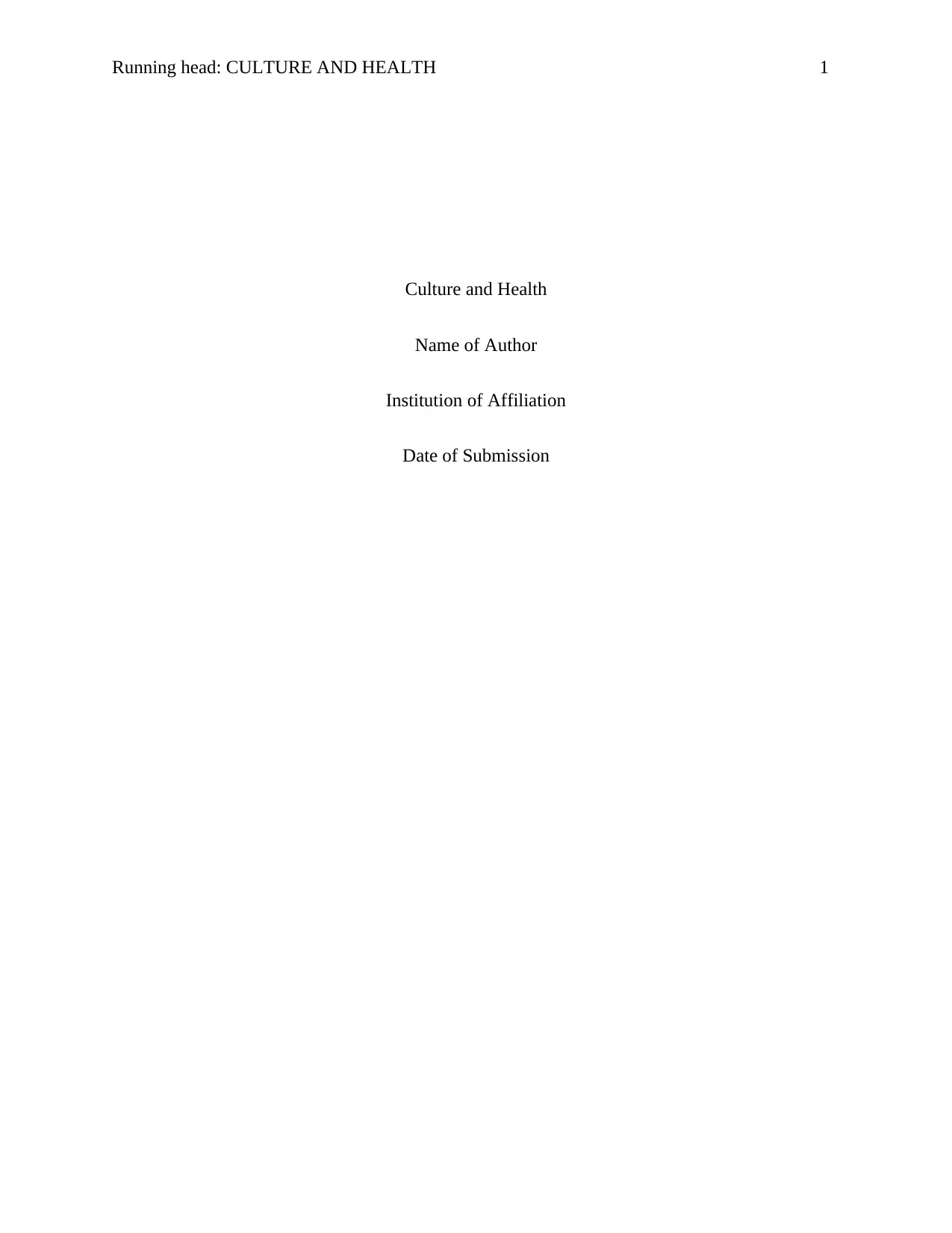
Running head: CULTURE AND HEALTH 1
Culture and Health
Name of Author
Institution of Affiliation
Date of Submission
Culture and Health
Name of Author
Institution of Affiliation
Date of Submission
Paraphrase This Document
Need a fresh take? Get an instant paraphrase of this document with our AI Paraphraser
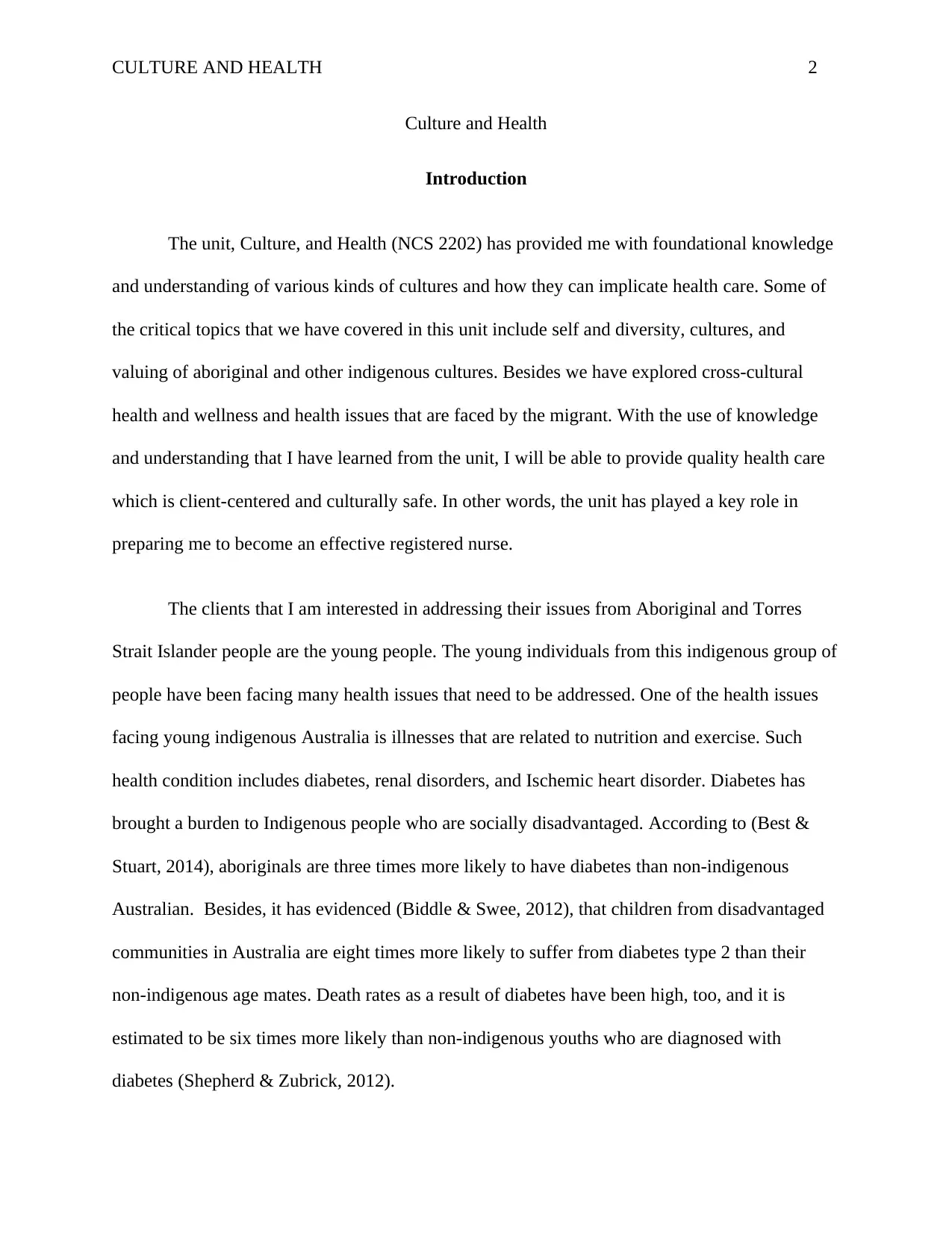
CULTURE AND HEALTH 2
Culture and Health
Introduction
The unit, Culture, and Health (NCS 2202) has provided me with foundational knowledge
and understanding of various kinds of cultures and how they can implicate health care. Some of
the critical topics that we have covered in this unit include self and diversity, cultures, and
valuing of aboriginal and other indigenous cultures. Besides we have explored cross-cultural
health and wellness and health issues that are faced by the migrant. With the use of knowledge
and understanding that I have learned from the unit, I will be able to provide quality health care
which is client-centered and culturally safe. In other words, the unit has played a key role in
preparing me to become an effective registered nurse.
The clients that I am interested in addressing their issues from Aboriginal and Torres
Strait Islander people are the young people. The young individuals from this indigenous group of
people have been facing many health issues that need to be addressed. One of the health issues
facing young indigenous Australia is illnesses that are related to nutrition and exercise. Such
health condition includes diabetes, renal disorders, and Ischemic heart disorder. Diabetes has
brought a burden to Indigenous people who are socially disadvantaged. According to (Best &
Stuart, 2014), aboriginals are three times more likely to have diabetes than non-indigenous
Australian. Besides, it has evidenced (Biddle & Swee, 2012), that children from disadvantaged
communities in Australia are eight times more likely to suffer from diabetes type 2 than their
non-indigenous age mates. Death rates as a result of diabetes have been high, too, and it is
estimated to be six times more likely than non-indigenous youths who are diagnosed with
diabetes (Shepherd & Zubrick, 2012).
Culture and Health
Introduction
The unit, Culture, and Health (NCS 2202) has provided me with foundational knowledge
and understanding of various kinds of cultures and how they can implicate health care. Some of
the critical topics that we have covered in this unit include self and diversity, cultures, and
valuing of aboriginal and other indigenous cultures. Besides we have explored cross-cultural
health and wellness and health issues that are faced by the migrant. With the use of knowledge
and understanding that I have learned from the unit, I will be able to provide quality health care
which is client-centered and culturally safe. In other words, the unit has played a key role in
preparing me to become an effective registered nurse.
The clients that I am interested in addressing their issues from Aboriginal and Torres
Strait Islander people are the young people. The young individuals from this indigenous group of
people have been facing many health issues that need to be addressed. One of the health issues
facing young indigenous Australia is illnesses that are related to nutrition and exercise. Such
health condition includes diabetes, renal disorders, and Ischemic heart disorder. Diabetes has
brought a burden to Indigenous people who are socially disadvantaged. According to (Best &
Stuart, 2014), aboriginals are three times more likely to have diabetes than non-indigenous
Australian. Besides, it has evidenced (Biddle & Swee, 2012), that children from disadvantaged
communities in Australia are eight times more likely to suffer from diabetes type 2 than their
non-indigenous age mates. Death rates as a result of diabetes have been high, too, and it is
estimated to be six times more likely than non-indigenous youths who are diagnosed with
diabetes (Shepherd & Zubrick, 2012).
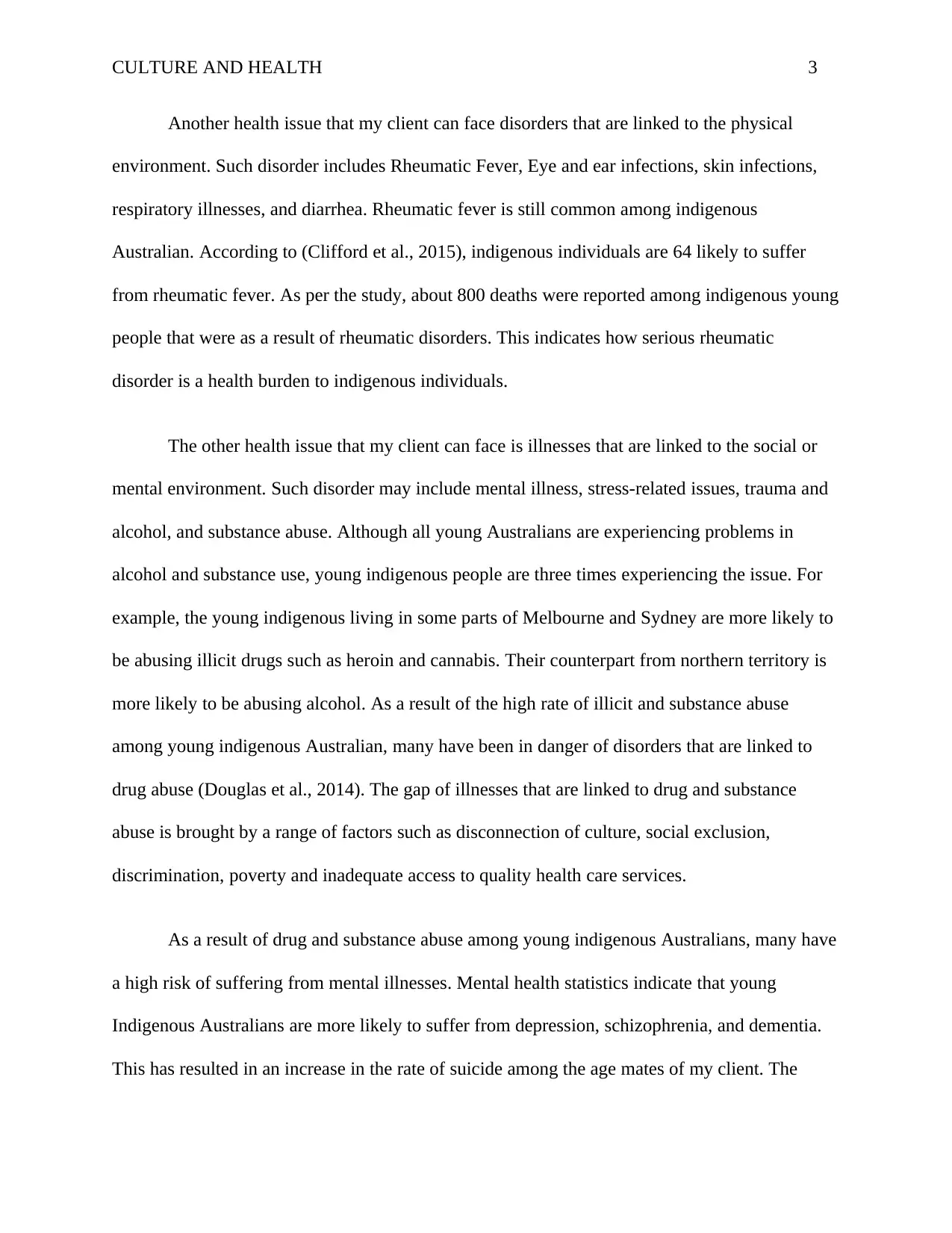
CULTURE AND HEALTH 3
Another health issue that my client can face disorders that are linked to the physical
environment. Such disorder includes Rheumatic Fever, Eye and ear infections, skin infections,
respiratory illnesses, and diarrhea. Rheumatic fever is still common among indigenous
Australian. According to (Clifford et al., 2015), indigenous individuals are 64 likely to suffer
from rheumatic fever. As per the study, about 800 deaths were reported among indigenous young
people that were as a result of rheumatic disorders. This indicates how serious rheumatic
disorder is a health burden to indigenous individuals.
The other health issue that my client can face is illnesses that are linked to the social or
mental environment. Such disorder may include mental illness, stress-related issues, trauma and
alcohol, and substance abuse. Although all young Australians are experiencing problems in
alcohol and substance use, young indigenous people are three times experiencing the issue. For
example, the young indigenous living in some parts of Melbourne and Sydney are more likely to
be abusing illicit drugs such as heroin and cannabis. Their counterpart from northern territory is
more likely to be abusing alcohol. As a result of the high rate of illicit and substance abuse
among young indigenous Australian, many have been in danger of disorders that are linked to
drug abuse (Douglas et al., 2014). The gap of illnesses that are linked to drug and substance
abuse is brought by a range of factors such as disconnection of culture, social exclusion,
discrimination, poverty and inadequate access to quality health care services.
As a result of drug and substance abuse among young indigenous Australians, many have
a high risk of suffering from mental illnesses. Mental health statistics indicate that young
Indigenous Australians are more likely to suffer from depression, schizophrenia, and dementia.
This has resulted in an increase in the rate of suicide among the age mates of my client. The
Another health issue that my client can face disorders that are linked to the physical
environment. Such disorder includes Rheumatic Fever, Eye and ear infections, skin infections,
respiratory illnesses, and diarrhea. Rheumatic fever is still common among indigenous
Australian. According to (Clifford et al., 2015), indigenous individuals are 64 likely to suffer
from rheumatic fever. As per the study, about 800 deaths were reported among indigenous young
people that were as a result of rheumatic disorders. This indicates how serious rheumatic
disorder is a health burden to indigenous individuals.
The other health issue that my client can face is illnesses that are linked to the social or
mental environment. Such disorder may include mental illness, stress-related issues, trauma and
alcohol, and substance abuse. Although all young Australians are experiencing problems in
alcohol and substance use, young indigenous people are three times experiencing the issue. For
example, the young indigenous living in some parts of Melbourne and Sydney are more likely to
be abusing illicit drugs such as heroin and cannabis. Their counterpart from northern territory is
more likely to be abusing alcohol. As a result of the high rate of illicit and substance abuse
among young indigenous Australian, many have been in danger of disorders that are linked to
drug abuse (Douglas et al., 2014). The gap of illnesses that are linked to drug and substance
abuse is brought by a range of factors such as disconnection of culture, social exclusion,
discrimination, poverty and inadequate access to quality health care services.
As a result of drug and substance abuse among young indigenous Australians, many have
a high risk of suffering from mental illnesses. Mental health statistics indicate that young
Indigenous Australians are more likely to suffer from depression, schizophrenia, and dementia.
This has resulted in an increase in the rate of suicide among the age mates of my client. The
⊘ This is a preview!⊘
Do you want full access?
Subscribe today to unlock all pages.

Trusted by 1+ million students worldwide
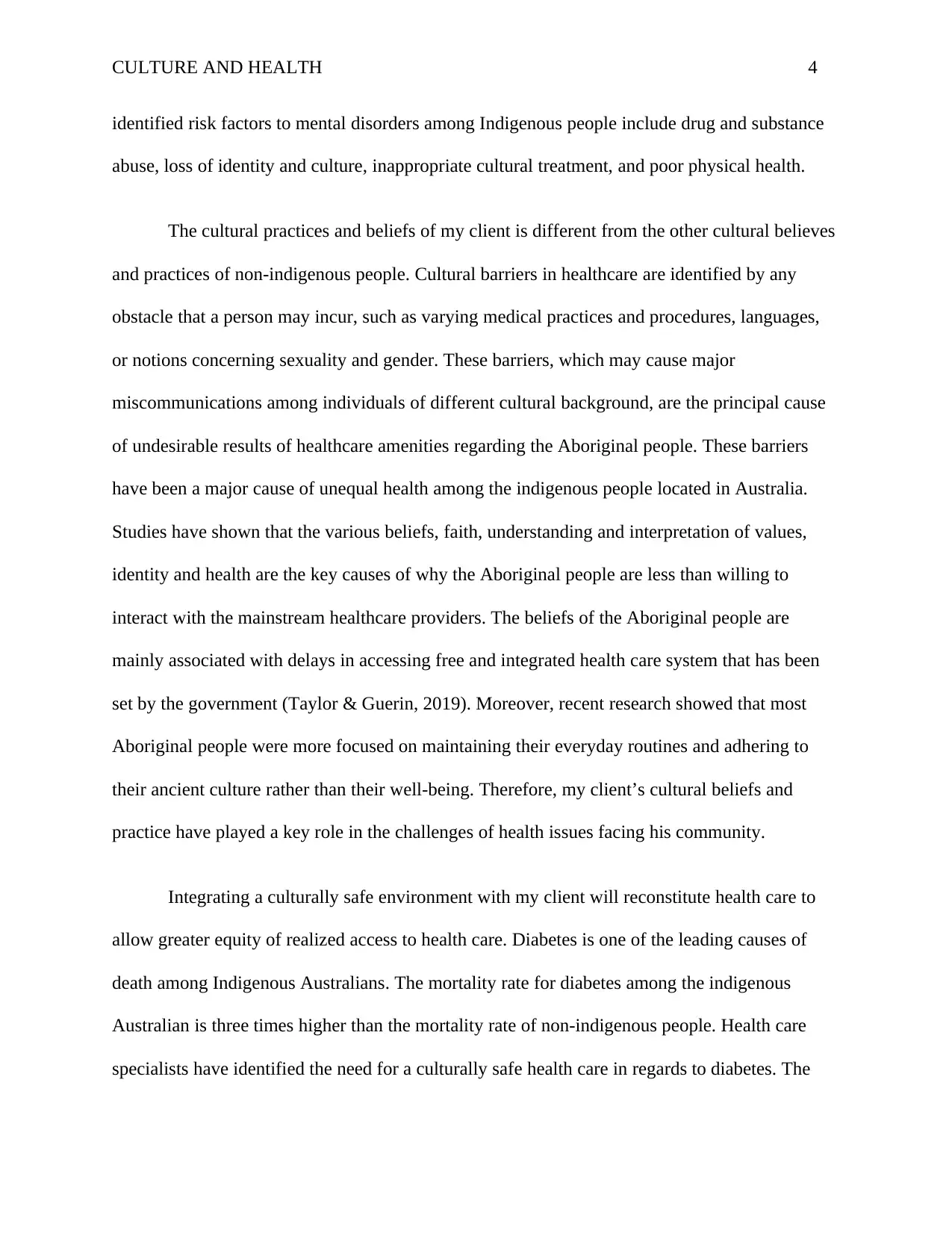
CULTURE AND HEALTH 4
identified risk factors to mental disorders among Indigenous people include drug and substance
abuse, loss of identity and culture, inappropriate cultural treatment, and poor physical health.
The cultural practices and beliefs of my client is different from the other cultural believes
and practices of non-indigenous people. Cultural barriers in healthcare are identified by any
obstacle that a person may incur, such as varying medical practices and procedures, languages,
or notions concerning sexuality and gender. These barriers, which may cause major
miscommunications among individuals of different cultural background, are the principal cause
of undesirable results of healthcare amenities regarding the Aboriginal people. These barriers
have been a major cause of unequal health among the indigenous people located in Australia.
Studies have shown that the various beliefs, faith, understanding and interpretation of values,
identity and health are the key causes of why the Aboriginal people are less than willing to
interact with the mainstream healthcare providers. The beliefs of the Aboriginal people are
mainly associated with delays in accessing free and integrated health care system that has been
set by the government (Taylor & Guerin, 2019). Moreover, recent research showed that most
Aboriginal people were more focused on maintaining their everyday routines and adhering to
their ancient culture rather than their well-being. Therefore, my client’s cultural beliefs and
practice have played a key role in the challenges of health issues facing his community.
Integrating a culturally safe environment with my client will reconstitute health care to
allow greater equity of realized access to health care. Diabetes is one of the leading causes of
death among Indigenous Australians. The mortality rate for diabetes among the indigenous
Australian is three times higher than the mortality rate of non-indigenous people. Health care
specialists have identified the need for a culturally safe health care in regards to diabetes. The
identified risk factors to mental disorders among Indigenous people include drug and substance
abuse, loss of identity and culture, inappropriate cultural treatment, and poor physical health.
The cultural practices and beliefs of my client is different from the other cultural believes
and practices of non-indigenous people. Cultural barriers in healthcare are identified by any
obstacle that a person may incur, such as varying medical practices and procedures, languages,
or notions concerning sexuality and gender. These barriers, which may cause major
miscommunications among individuals of different cultural background, are the principal cause
of undesirable results of healthcare amenities regarding the Aboriginal people. These barriers
have been a major cause of unequal health among the indigenous people located in Australia.
Studies have shown that the various beliefs, faith, understanding and interpretation of values,
identity and health are the key causes of why the Aboriginal people are less than willing to
interact with the mainstream healthcare providers. The beliefs of the Aboriginal people are
mainly associated with delays in accessing free and integrated health care system that has been
set by the government (Taylor & Guerin, 2019). Moreover, recent research showed that most
Aboriginal people were more focused on maintaining their everyday routines and adhering to
their ancient culture rather than their well-being. Therefore, my client’s cultural beliefs and
practice have played a key role in the challenges of health issues facing his community.
Integrating a culturally safe environment with my client will reconstitute health care to
allow greater equity of realized access to health care. Diabetes is one of the leading causes of
death among Indigenous Australians. The mortality rate for diabetes among the indigenous
Australian is three times higher than the mortality rate of non-indigenous people. Health care
specialists have identified the need for a culturally safe health care in regards to diabetes. The
Paraphrase This Document
Need a fresh take? Get an instant paraphrase of this document with our AI Paraphraser
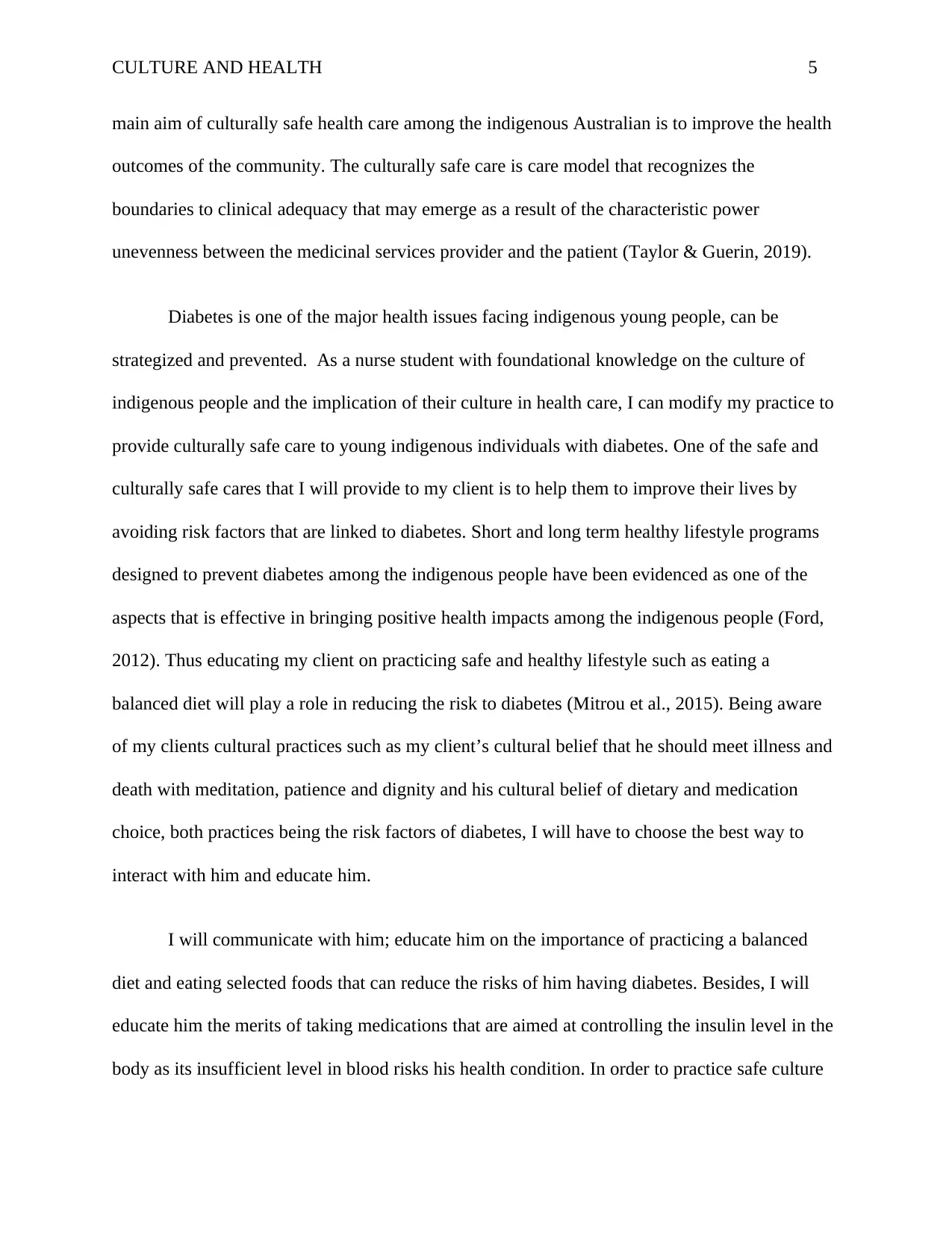
CULTURE AND HEALTH 5
main aim of culturally safe health care among the indigenous Australian is to improve the health
outcomes of the community. The culturally safe care is care model that recognizes the
boundaries to clinical adequacy that may emerge as a result of the characteristic power
unevenness between the medicinal services provider and the patient (Taylor & Guerin, 2019).
Diabetes is one of the major health issues facing indigenous young people, can be
strategized and prevented. As a nurse student with foundational knowledge on the culture of
indigenous people and the implication of their culture in health care, I can modify my practice to
provide culturally safe care to young indigenous individuals with diabetes. One of the safe and
culturally safe cares that I will provide to my client is to help them to improve their lives by
avoiding risk factors that are linked to diabetes. Short and long term healthy lifestyle programs
designed to prevent diabetes among the indigenous people have been evidenced as one of the
aspects that is effective in bringing positive health impacts among the indigenous people (Ford,
2012). Thus educating my client on practicing safe and healthy lifestyle such as eating a
balanced diet will play a role in reducing the risk to diabetes (Mitrou et al., 2015). Being aware
of my clients cultural practices such as my client’s cultural belief that he should meet illness and
death with meditation, patience and dignity and his cultural belief of dietary and medication
choice, both practices being the risk factors of diabetes, I will have to choose the best way to
interact with him and educate him.
I will communicate with him; educate him on the importance of practicing a balanced
diet and eating selected foods that can reduce the risks of him having diabetes. Besides, I will
educate him the merits of taking medications that are aimed at controlling the insulin level in the
body as its insufficient level in blood risks his health condition. In order to practice safe culture
main aim of culturally safe health care among the indigenous Australian is to improve the health
outcomes of the community. The culturally safe care is care model that recognizes the
boundaries to clinical adequacy that may emerge as a result of the characteristic power
unevenness between the medicinal services provider and the patient (Taylor & Guerin, 2019).
Diabetes is one of the major health issues facing indigenous young people, can be
strategized and prevented. As a nurse student with foundational knowledge on the culture of
indigenous people and the implication of their culture in health care, I can modify my practice to
provide culturally safe care to young indigenous individuals with diabetes. One of the safe and
culturally safe cares that I will provide to my client is to help them to improve their lives by
avoiding risk factors that are linked to diabetes. Short and long term healthy lifestyle programs
designed to prevent diabetes among the indigenous people have been evidenced as one of the
aspects that is effective in bringing positive health impacts among the indigenous people (Ford,
2012). Thus educating my client on practicing safe and healthy lifestyle such as eating a
balanced diet will play a role in reducing the risk to diabetes (Mitrou et al., 2015). Being aware
of my clients cultural practices such as my client’s cultural belief that he should meet illness and
death with meditation, patience and dignity and his cultural belief of dietary and medication
choice, both practices being the risk factors of diabetes, I will have to choose the best way to
interact with him and educate him.
I will communicate with him; educate him on the importance of practicing a balanced
diet and eating selected foods that can reduce the risks of him having diabetes. Besides, I will
educate him the merits of taking medications that are aimed at controlling the insulin level in the
body as its insufficient level in blood risks his health condition. In order to practice safe culture
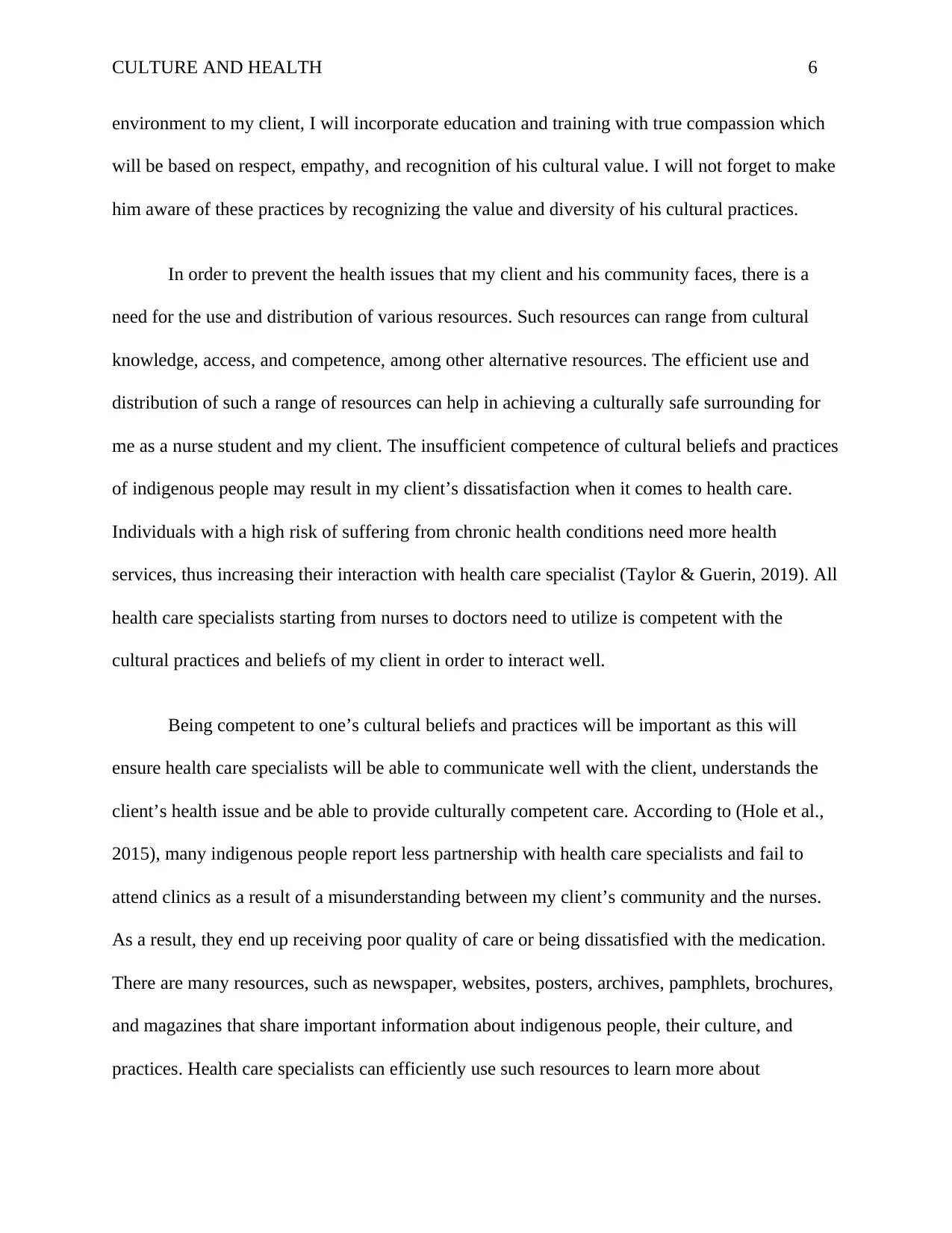
CULTURE AND HEALTH 6
environment to my client, I will incorporate education and training with true compassion which
will be based on respect, empathy, and recognition of his cultural value. I will not forget to make
him aware of these practices by recognizing the value and diversity of his cultural practices.
In order to prevent the health issues that my client and his community faces, there is a
need for the use and distribution of various resources. Such resources can range from cultural
knowledge, access, and competence, among other alternative resources. The efficient use and
distribution of such a range of resources can help in achieving a culturally safe surrounding for
me as a nurse student and my client. The insufficient competence of cultural beliefs and practices
of indigenous people may result in my client’s dissatisfaction when it comes to health care.
Individuals with a high risk of suffering from chronic health conditions need more health
services, thus increasing their interaction with health care specialist (Taylor & Guerin, 2019). All
health care specialists starting from nurses to doctors need to utilize is competent with the
cultural practices and beliefs of my client in order to interact well.
Being competent to one’s cultural beliefs and practices will be important as this will
ensure health care specialists will be able to communicate well with the client, understands the
client’s health issue and be able to provide culturally competent care. According to (Hole et al.,
2015), many indigenous people report less partnership with health care specialists and fail to
attend clinics as a result of a misunderstanding between my client’s community and the nurses.
As a result, they end up receiving poor quality of care or being dissatisfied with the medication.
There are many resources, such as newspaper, websites, posters, archives, pamphlets, brochures,
and magazines that share important information about indigenous people, their culture, and
practices. Health care specialists can efficiently use such resources to learn more about
environment to my client, I will incorporate education and training with true compassion which
will be based on respect, empathy, and recognition of his cultural value. I will not forget to make
him aware of these practices by recognizing the value and diversity of his cultural practices.
In order to prevent the health issues that my client and his community faces, there is a
need for the use and distribution of various resources. Such resources can range from cultural
knowledge, access, and competence, among other alternative resources. The efficient use and
distribution of such a range of resources can help in achieving a culturally safe surrounding for
me as a nurse student and my client. The insufficient competence of cultural beliefs and practices
of indigenous people may result in my client’s dissatisfaction when it comes to health care.
Individuals with a high risk of suffering from chronic health conditions need more health
services, thus increasing their interaction with health care specialist (Taylor & Guerin, 2019). All
health care specialists starting from nurses to doctors need to utilize is competent with the
cultural practices and beliefs of my client in order to interact well.
Being competent to one’s cultural beliefs and practices will be important as this will
ensure health care specialists will be able to communicate well with the client, understands the
client’s health issue and be able to provide culturally competent care. According to (Hole et al.,
2015), many indigenous people report less partnership with health care specialists and fail to
attend clinics as a result of a misunderstanding between my client’s community and the nurses.
As a result, they end up receiving poor quality of care or being dissatisfied with the medication.
There are many resources, such as newspaper, websites, posters, archives, pamphlets, brochures,
and magazines that share important information about indigenous people, their culture, and
practices. Health care specialists can efficiently use such resources to learn more about
⊘ This is a preview!⊘
Do you want full access?
Subscribe today to unlock all pages.

Trusted by 1+ million students worldwide
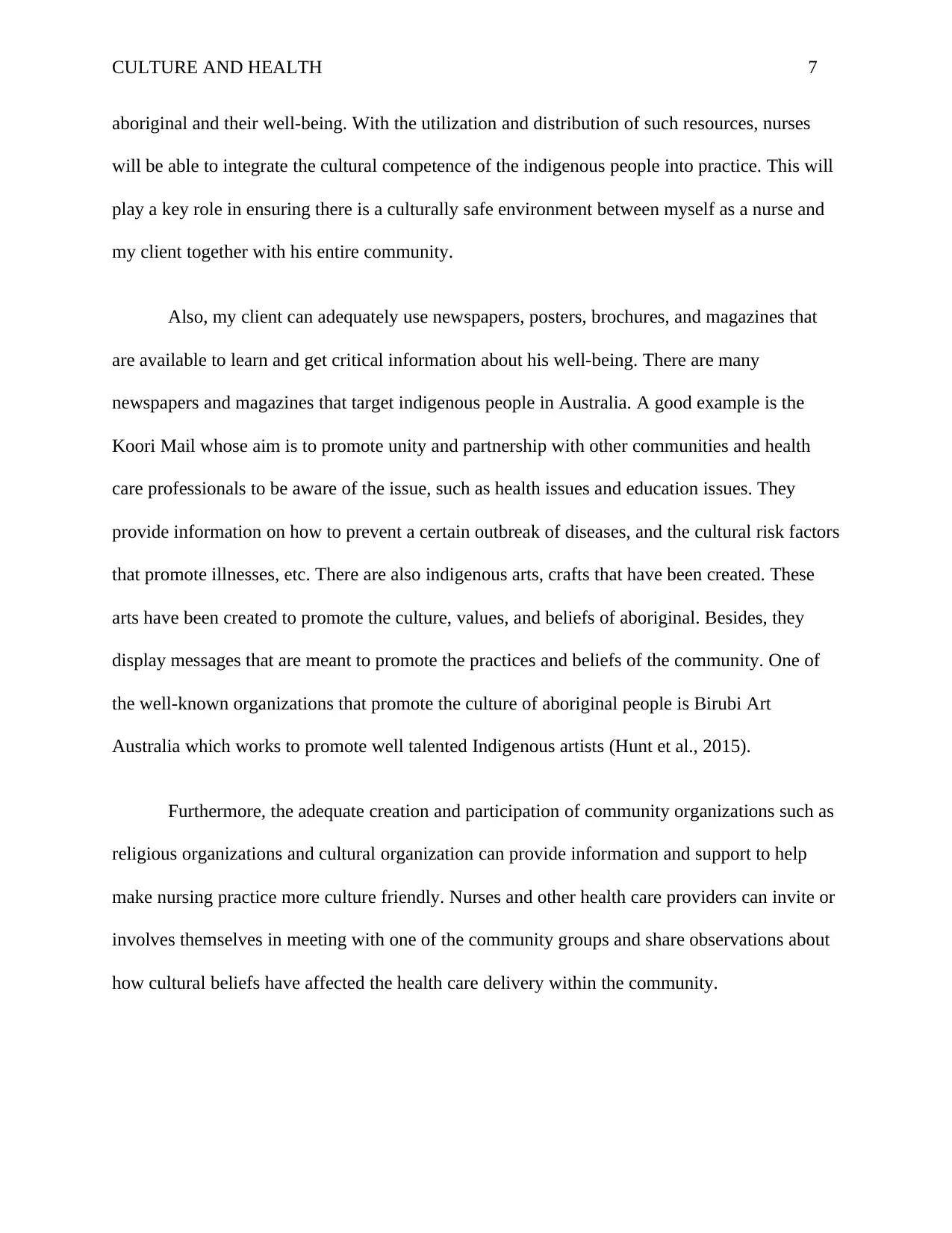
CULTURE AND HEALTH 7
aboriginal and their well-being. With the utilization and distribution of such resources, nurses
will be able to integrate the cultural competence of the indigenous people into practice. This will
play a key role in ensuring there is a culturally safe environment between myself as a nurse and
my client together with his entire community.
Also, my client can adequately use newspapers, posters, brochures, and magazines that
are available to learn and get critical information about his well-being. There are many
newspapers and magazines that target indigenous people in Australia. A good example is the
Koori Mail whose aim is to promote unity and partnership with other communities and health
care professionals to be aware of the issue, such as health issues and education issues. They
provide information on how to prevent a certain outbreak of diseases, and the cultural risk factors
that promote illnesses, etc. There are also indigenous arts, crafts that have been created. These
arts have been created to promote the culture, values, and beliefs of aboriginal. Besides, they
display messages that are meant to promote the practices and beliefs of the community. One of
the well-known organizations that promote the culture of aboriginal people is Birubi Art
Australia which works to promote well talented Indigenous artists (Hunt et al., 2015).
Furthermore, the adequate creation and participation of community organizations such as
religious organizations and cultural organization can provide information and support to help
make nursing practice more culture friendly. Nurses and other health care providers can invite or
involves themselves in meeting with one of the community groups and share observations about
how cultural beliefs have affected the health care delivery within the community.
aboriginal and their well-being. With the utilization and distribution of such resources, nurses
will be able to integrate the cultural competence of the indigenous people into practice. This will
play a key role in ensuring there is a culturally safe environment between myself as a nurse and
my client together with his entire community.
Also, my client can adequately use newspapers, posters, brochures, and magazines that
are available to learn and get critical information about his well-being. There are many
newspapers and magazines that target indigenous people in Australia. A good example is the
Koori Mail whose aim is to promote unity and partnership with other communities and health
care professionals to be aware of the issue, such as health issues and education issues. They
provide information on how to prevent a certain outbreak of diseases, and the cultural risk factors
that promote illnesses, etc. There are also indigenous arts, crafts that have been created. These
arts have been created to promote the culture, values, and beliefs of aboriginal. Besides, they
display messages that are meant to promote the practices and beliefs of the community. One of
the well-known organizations that promote the culture of aboriginal people is Birubi Art
Australia which works to promote well talented Indigenous artists (Hunt et al., 2015).
Furthermore, the adequate creation and participation of community organizations such as
religious organizations and cultural organization can provide information and support to help
make nursing practice more culture friendly. Nurses and other health care providers can invite or
involves themselves in meeting with one of the community groups and share observations about
how cultural beliefs have affected the health care delivery within the community.
Paraphrase This Document
Need a fresh take? Get an instant paraphrase of this document with our AI Paraphraser
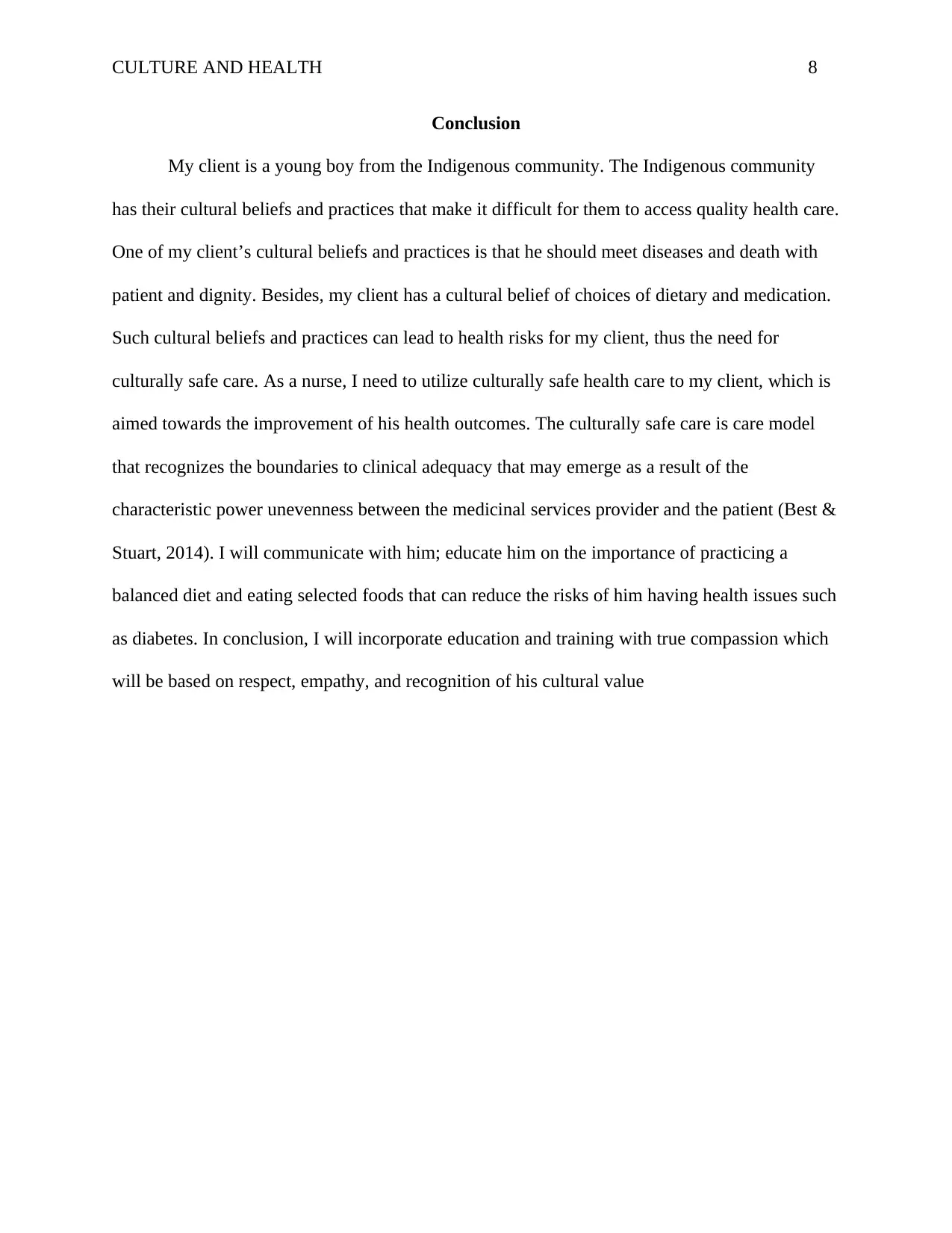
CULTURE AND HEALTH 8
Conclusion
My client is a young boy from the Indigenous community. The Indigenous community
has their cultural beliefs and practices that make it difficult for them to access quality health care.
One of my client’s cultural beliefs and practices is that he should meet diseases and death with
patient and dignity. Besides, my client has a cultural belief of choices of dietary and medication.
Such cultural beliefs and practices can lead to health risks for my client, thus the need for
culturally safe care. As a nurse, I need to utilize culturally safe health care to my client, which is
aimed towards the improvement of his health outcomes. The culturally safe care is care model
that recognizes the boundaries to clinical adequacy that may emerge as a result of the
characteristic power unevenness between the medicinal services provider and the patient (Best &
Stuart, 2014). I will communicate with him; educate him on the importance of practicing a
balanced diet and eating selected foods that can reduce the risks of him having health issues such
as diabetes. In conclusion, I will incorporate education and training with true compassion which
will be based on respect, empathy, and recognition of his cultural value
Conclusion
My client is a young boy from the Indigenous community. The Indigenous community
has their cultural beliefs and practices that make it difficult for them to access quality health care.
One of my client’s cultural beliefs and practices is that he should meet diseases and death with
patient and dignity. Besides, my client has a cultural belief of choices of dietary and medication.
Such cultural beliefs and practices can lead to health risks for my client, thus the need for
culturally safe care. As a nurse, I need to utilize culturally safe health care to my client, which is
aimed towards the improvement of his health outcomes. The culturally safe care is care model
that recognizes the boundaries to clinical adequacy that may emerge as a result of the
characteristic power unevenness between the medicinal services provider and the patient (Best &
Stuart, 2014). I will communicate with him; educate him on the importance of practicing a
balanced diet and eating selected foods that can reduce the risks of him having health issues such
as diabetes. In conclusion, I will incorporate education and training with true compassion which
will be based on respect, empathy, and recognition of his cultural value
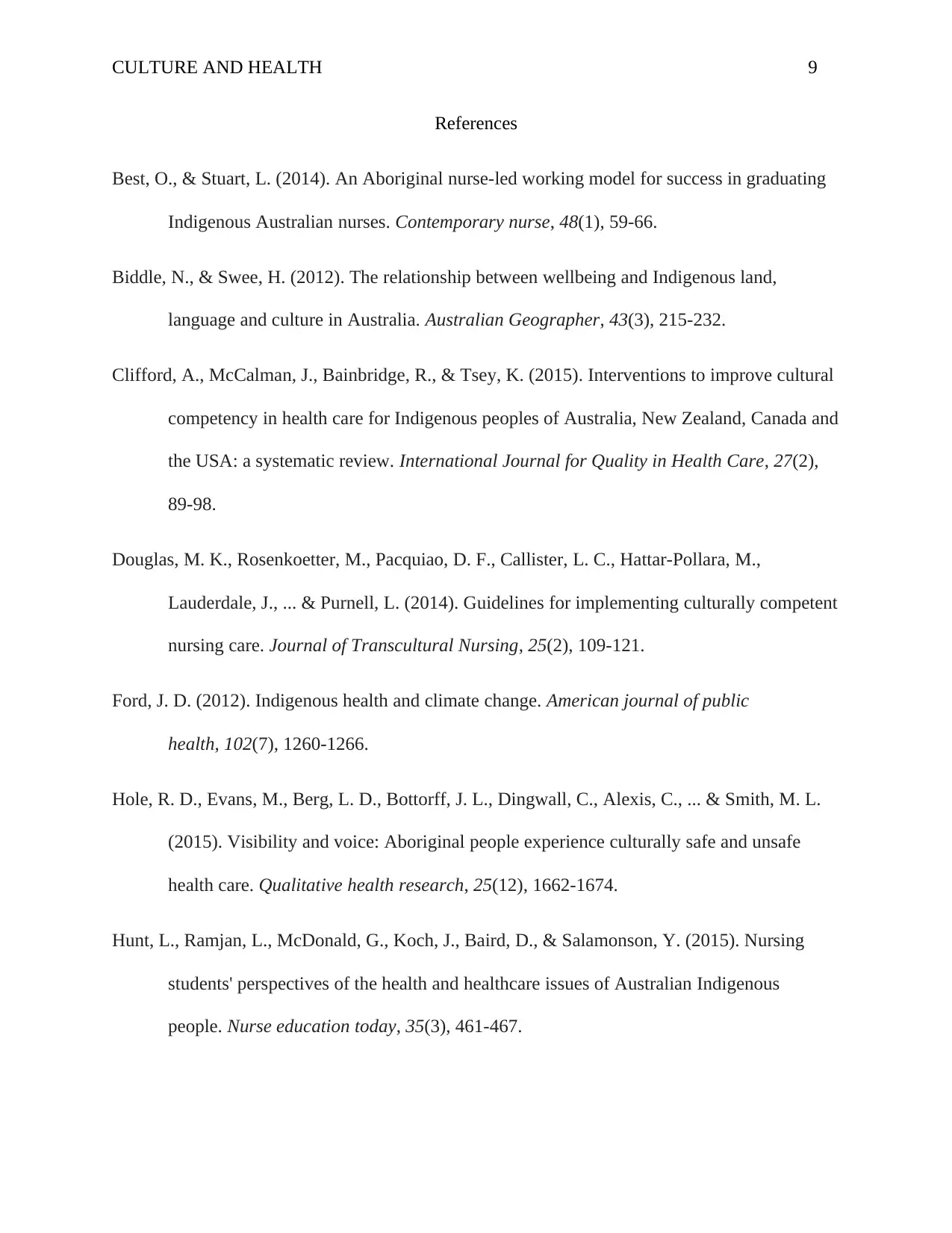
CULTURE AND HEALTH 9
References
Best, O., & Stuart, L. (2014). An Aboriginal nurse-led working model for success in graduating
Indigenous Australian nurses. Contemporary nurse, 48(1), 59-66.
Biddle, N., & Swee, H. (2012). The relationship between wellbeing and Indigenous land,
language and culture in Australia. Australian Geographer, 43(3), 215-232.
Clifford, A., McCalman, J., Bainbridge, R., & Tsey, K. (2015). Interventions to improve cultural
competency in health care for Indigenous peoples of Australia, New Zealand, Canada and
the USA: a systematic review. International Journal for Quality in Health Care, 27(2),
89-98.
Douglas, M. K., Rosenkoetter, M., Pacquiao, D. F., Callister, L. C., Hattar-Pollara, M.,
Lauderdale, J., ... & Purnell, L. (2014). Guidelines for implementing culturally competent
nursing care. Journal of Transcultural Nursing, 25(2), 109-121.
Ford, J. D. (2012). Indigenous health and climate change. American journal of public
health, 102(7), 1260-1266.
Hole, R. D., Evans, M., Berg, L. D., Bottorff, J. L., Dingwall, C., Alexis, C., ... & Smith, M. L.
(2015). Visibility and voice: Aboriginal people experience culturally safe and unsafe
health care. Qualitative health research, 25(12), 1662-1674.
Hunt, L., Ramjan, L., McDonald, G., Koch, J., Baird, D., & Salamonson, Y. (2015). Nursing
students' perspectives of the health and healthcare issues of Australian Indigenous
people. Nurse education today, 35(3), 461-467.
References
Best, O., & Stuart, L. (2014). An Aboriginal nurse-led working model for success in graduating
Indigenous Australian nurses. Contemporary nurse, 48(1), 59-66.
Biddle, N., & Swee, H. (2012). The relationship between wellbeing and Indigenous land,
language and culture in Australia. Australian Geographer, 43(3), 215-232.
Clifford, A., McCalman, J., Bainbridge, R., & Tsey, K. (2015). Interventions to improve cultural
competency in health care for Indigenous peoples of Australia, New Zealand, Canada and
the USA: a systematic review. International Journal for Quality in Health Care, 27(2),
89-98.
Douglas, M. K., Rosenkoetter, M., Pacquiao, D. F., Callister, L. C., Hattar-Pollara, M.,
Lauderdale, J., ... & Purnell, L. (2014). Guidelines for implementing culturally competent
nursing care. Journal of Transcultural Nursing, 25(2), 109-121.
Ford, J. D. (2012). Indigenous health and climate change. American journal of public
health, 102(7), 1260-1266.
Hole, R. D., Evans, M., Berg, L. D., Bottorff, J. L., Dingwall, C., Alexis, C., ... & Smith, M. L.
(2015). Visibility and voice: Aboriginal people experience culturally safe and unsafe
health care. Qualitative health research, 25(12), 1662-1674.
Hunt, L., Ramjan, L., McDonald, G., Koch, J., Baird, D., & Salamonson, Y. (2015). Nursing
students' perspectives of the health and healthcare issues of Australian Indigenous
people. Nurse education today, 35(3), 461-467.
⊘ This is a preview!⊘
Do you want full access?
Subscribe today to unlock all pages.

Trusted by 1+ million students worldwide
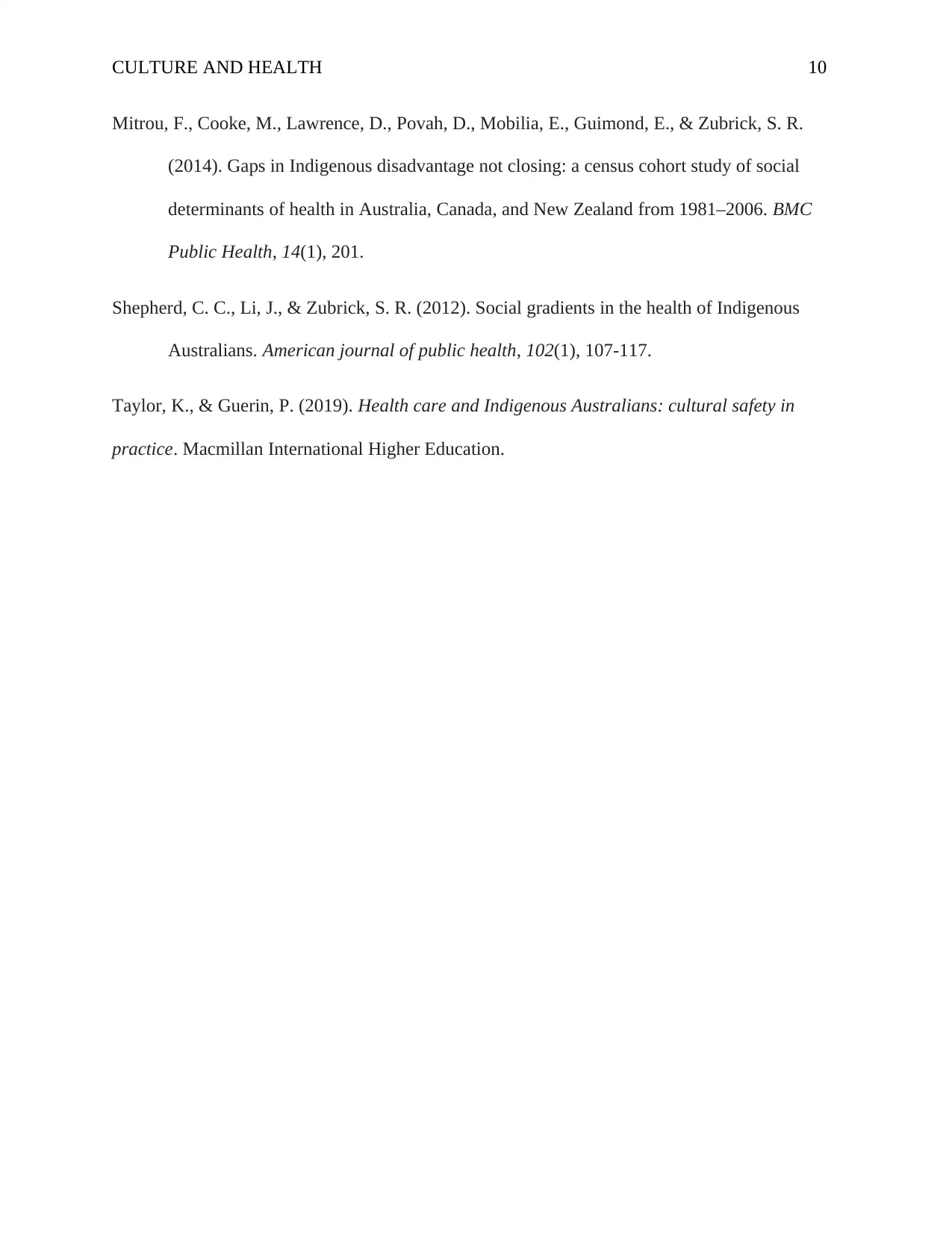
CULTURE AND HEALTH 10
Mitrou, F., Cooke, M., Lawrence, D., Povah, D., Mobilia, E., Guimond, E., & Zubrick, S. R.
(2014). Gaps in Indigenous disadvantage not closing: a census cohort study of social
determinants of health in Australia, Canada, and New Zealand from 1981–2006. BMC
Public Health, 14(1), 201.
Shepherd, C. C., Li, J., & Zubrick, S. R. (2012). Social gradients in the health of Indigenous
Australians. American journal of public health, 102(1), 107-117.
Taylor, K., & Guerin, P. (2019). Health care and Indigenous Australians: cultural safety in
practice. Macmillan International Higher Education.
Mitrou, F., Cooke, M., Lawrence, D., Povah, D., Mobilia, E., Guimond, E., & Zubrick, S. R.
(2014). Gaps in Indigenous disadvantage not closing: a census cohort study of social
determinants of health in Australia, Canada, and New Zealand from 1981–2006. BMC
Public Health, 14(1), 201.
Shepherd, C. C., Li, J., & Zubrick, S. R. (2012). Social gradients in the health of Indigenous
Australians. American journal of public health, 102(1), 107-117.
Taylor, K., & Guerin, P. (2019). Health care and Indigenous Australians: cultural safety in
practice. Macmillan International Higher Education.
1 out of 10
Related Documents
Your All-in-One AI-Powered Toolkit for Academic Success.
+13062052269
info@desklib.com
Available 24*7 on WhatsApp / Email
![[object Object]](/_next/static/media/star-bottom.7253800d.svg)
Unlock your academic potential
Copyright © 2020–2025 A2Z Services. All Rights Reserved. Developed and managed by ZUCOL.





